Research "Standard". Development of anti-aircraft systems of military air defense
The existing plans of the Ministry of Defense and the views of specialists were announced at a recent military-technical conference. March 23 in Izhevsk, on the basis of the IEMZ Kupol enterprise, a meeting was held on the “Advanced anti-aircraft missile system of a short-range military air defense. His place in the guise of military air defense for the period 2030-2035's. " The event was led by the Commander-in-Chief of the Ground Forces, Colonel-General Oleg Salyukov. Also in the meeting was attended by the head of Udmurtia Alexander Soloviev, the head of the army air defense of the ground forces, Lieutenant-General Alexander Leonov and other representatives of the armed forces and industry.
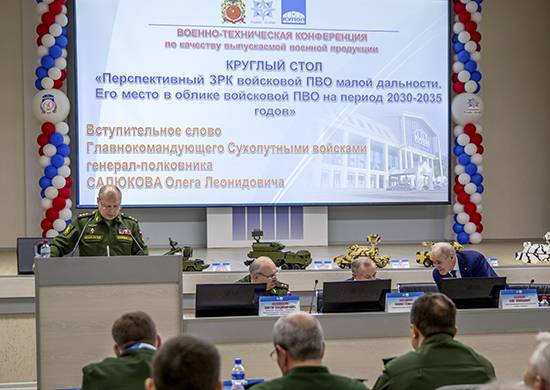
Round table “Perspective anti-aircraft missile system of short-range military air defense. His place in the guise of military air defense for the period 2030-2035's. " Photo of the Ministry of Defense of the Russian Federation
During the round table, defense industry experts and the military read out two dozen reports on these or other features of the development of air defense systems, the specifics of their work, changes in the appearance of air defense, etc. The army and industry discussed the issues raised and made some conclusions. In addition, recommendations were made on the conduct of new research projects, which in the long term will lead to the emergence of new weapons.
Some details of the development of military air defense announced Lt. Gen. A. Leonov. Speaking at the round table, the commander said that starting from 2020, the main direction of the development of anti-aircraft systems would be the creation of a single multi-functional universal weapon system of the army air defense. During the first half of the next decade, a scientific and technical basis should be laid for the subsequent creation of such a system. To do this, open and conduct a series of breakthrough research projects.
In connection with the need for the further development of anti-aircraft complexes, the command of the ground forces came out with a proposal for new research projects. In 2018, it is proposed to launch a new research project under the code “Standard”. Leading organizations in the industry should be involved in its implementation.
During work on the “Standard” theme, the domestic industry will have to conduct an analysis of the technical capabilities of enterprises in the creation of promising models of air defense weapons for the ground forces. Among other things, it is required to study the possibility of using so-called. new physical principles of destruction. Then it is proposed to develop promising short-range and medium-range anti-aircraft missile systems. Other air defense systems can also be created. All new tools, including anti-aircraft systems and detection systems, should be combined into a common network-centric system.
Lieutenant General Leonov added that, based on the results of the Standard research work, breakthrough development work should be discovered later. Already in the course of these projects, information-compatible anti-aircraft weapons controlled by a single control system should be created. In new developments it is required to use the principles of modular construction, a high degree of unification and multifunctionality.
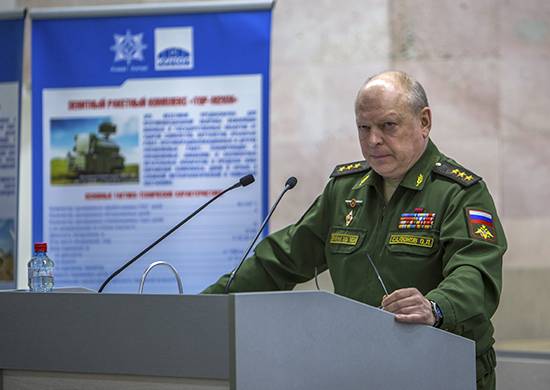
Speech by the Commander-in-Chief of the Ground Forces, Colonel-General O. Salyukov. Photo of the Ministry of Defense of the Russian Federation
In his speech, the commander-in-chief of the land forces clarified that his structure is currently working on its own recommendations, which should be taken into account by new research projects. Further, after carrying out the necessary R & D, with the active assistance of the ground forces, it is proposed to form a tactical and technical assignment for new projects of promising air defense systems.
In its official report on the last round table, the Department of Information and Mass Communications of the Ministry of Defense recalled that the main short-range anti-aircraft missile system in military air defense at the moment is the Tor-M2 system. The task of this complex is the implementation of air defense and missile defense at the divisional level. It can protect ground formations from cruise and anti-radar missiles, glide bombs, aircraft, helicopters and drones.
It is not difficult to notice that in the course of a recent event it was only about preparing for the development of promising projects. At the moment, the military has only the most general considerations regarding the appearance of promising air defense systems for the ground forces. Only next year it is expected to begin research work, which will identify existing and new threats, as well as formulate requirements for new projects. The completion of R & D “Standard” will allow to begin design work, but this will happen only after a few years - apparently, only at the beginning of the next decade.
The lack of accurate data on new anti-aircraft missile systems in the presence of information about the planned development of them was a good reason for discussions and forecasts. For several days now, domestic and foreign experts have been trying to predict what consequences recent statements by Russian military leaders will have, and what equipment ground forces can receive in the future. For obvious reasons, any current predictions can be justified, but one should not rule out another scenario as well. The emergence of new air defense systems is a matter of a very distant future, because of which many things can have time to change.
Bearing in mind the dubious nature of such a venture, we still try to present an exemplary image of promising air defense systems, the creation of which will contribute to the future research work "Standard". The goal of the entire program is to create an air defense system for the ground forces, which in itself can be a good hint in building new versions.
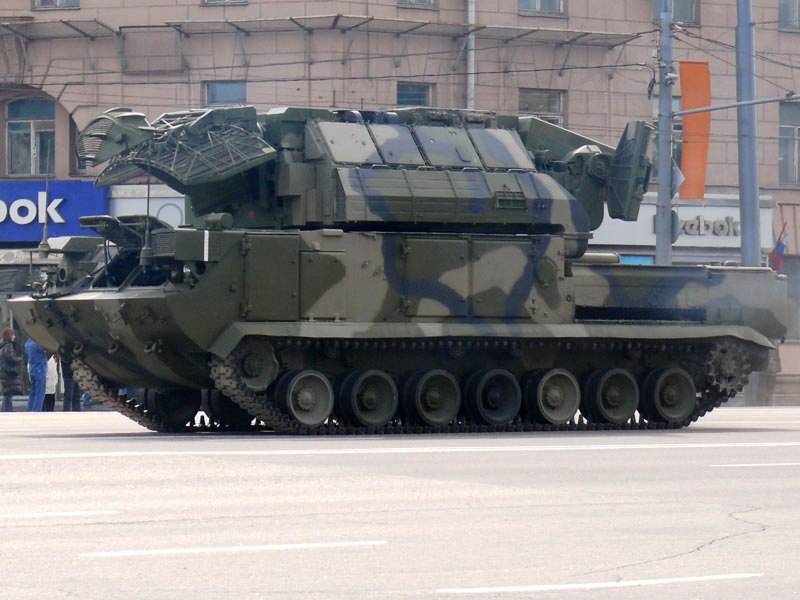
Modern TOR-M2. Wikimedia Commons Photos
One of the main features of anti-aircraft systems of military air defense is high mobility. The task of the complexes of this class is to escort columns of military equipment on the march and in places of concentration while ensuring reliable cover from possible air attacks. In this regard, any military air defense system must be based on a self-propelled chassis and have in its composition the minimum necessary set of components. In domestic practice, the most popular tracked chassis of several models that can carry all the required units, including detection systems and weapon.
The first results of the Standard program will appear no earlier than the middle of the next decade. According to current plans, by this time the ground forces will have to master the newest armored vehicles of new families. The development of unified armored platforms "Kurganets-25", "Boomerang" and "Armata" is underway. All of them, in theory, can be the basis for promising air defense systems. The use of such chassis will allow to unify anti-aircraft complexes with other armored vehicles of the troops, thereby simplifying the joint operation of different samples, and also possible problems with working in the same combat formations will be eliminated.
Currently, military air defense systems of short and medium range use rocket armament (“Thor” family) or a combined complex with missiles and cannons (“Pantsir-С1”). It is likely that in the future this approach to arming anti-aircraft systems will be maintained. Further development of missile weapons will allow to increase the main combat characteristics of the equipment in accordance with the requirements of the time. In addition, it is possible to save guns. In this case, the combined rocket-cannon complexes will be able to independently implement the echeloned defense with the destruction of targets in the optimal way.
In recent speeches, Russian military leaders, among other things, spoke about the use of new physical principles for hitting the target. What exactly was meant is not entirely clear, but such statements allow us to make the most courageous assumptions. Naturally, with the existing level of technology development, it is not worth waiting for the appearance of anti-aircraft weapons based on rail cannons, directional energy weapons, etc. Nevertheless, some existing developments in the field of alternative weapons systems may well find application in the field of air defense. Moreover, some such ideas have already been tested in practice.
High-power lasers are of particular interest in the context of the development of anti-aircraft systems. Several decades ago, self-propelled laser systems were created in our country, capable of striking the optoelectronic systems of aircraft. With the help of such an effect, the anti-aircraft complex could interfere with the attack or interfere with the correct operation of some guidance systems aviation means of destruction. Also, a hypothetical air defense complex of the distant future can use the principles of electronic warfare. A properly selected high-power jamming signal, directed directly at the target, could have the most serious impact on the operation of its on-board systems.
Regardless of the class and type of weapon used, the prospective complex must meet a number of critical requirements, which directly affect its combat effectiveness. The combat vehicle must have its own means of tracking the air situation, tracking the targets and pointing the weapon. At the same time, it is necessary to use communication and control systems that allow a separate complex to transfer the collected information to other consumers, as well as to receive target designation from third-party sources. Separate complexes and whole batteries should form a unified information network that “covers” large areas. Such a possibility will in some measure simplify the organization of air defense, as well as increase the combat capability of individual formations due to the possibility of timely notification of possible threats.
As the experience of operating modern air defense systems shows, the most important feature of their on-board equipment is the automation of various processes. In the future, this development trend of technology will continue, so that electronics will take on new functions and will be able to perform them much faster and more efficiently than humans. The operator will be able to manage the complex, controlling only the most important parameters and issuing basic commands.
In the context of interaction with the troops on the march, it is necessary to recall another important opportunity, so far not all of the domestic anti-aircraft complexes are available. Means of detection, tracking and attack should be able to shoot in motion. Unfortunately, at the moment only the latest complexes of the “Thor” family can move, simultaneously studying the air situation and launching missiles. Other systems need to stop to start.
Requirements for the range and altitude of hitting targets must be formed when developing a technical project for a new project. There is reason to believe that within the framework of the Standard research project, the development of requirements for several complexes of different classes with fundamentally different characteristics will be carried out at once. Currently, military air defense has a short-range air defense missile system, which is responsible for hitting targets at distances less than 15 km, short range (up to 30 km), medium (up to 100 km) and long range, destroying targets at distances more than 100 km. It is too early for now to say which classes will belong to the development of the Standard family. Judging by the known data, the development of new short-range systems, as well as short and medium range, is most likely.
The authors of promising projects will have to take into account the characteristic features of the development of aviation and other areas of this kind. Manned aircraft gradually receive means of reducing visibility, and are also equipped with more sophisticated means of destruction with an increased range of fire, allowing them to operate from outside the area of responsibility of the existing air defense missile systems. Also a serious problem are unmanned aerial vehicles, especially light and ultra light classes. Thus, the anti-aircraft systems of the new generation will have to learn to find and destroy a variety of goals, including very complex ones. Further development of manned and unmanned aircraft, as well as aircraft weapons will be a new challenge for promising air defense systems.
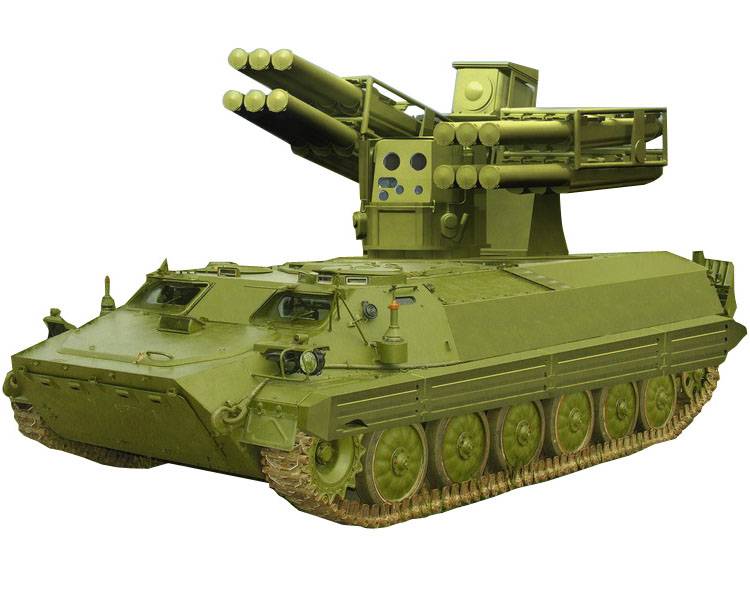
General view of the Pine air defense missile system. Figure NPO "High-precision complexes" / Npovk.ru
Another serious problem for anti-aircraft systems can be considered progress in the field of ground-based missiles. Even existing and operational tactical missile systems are a very difficult goal for modern air defense systems, and not all air defense weapons are capable of fighting them. Given these threats, we should expect that new anti-aircraft complexes, including short and medium range, will be able to intercept complex ballistic targets.
In general, there is reason to assume that, despite the expected time of appearance, the promising technology in terms of the basic features of the appearance, goals and objectives will not seriously differ from the existing samples. Moreover, it cannot be ruled out that as a result of the Standard research project, new complexes will appear, representing a deep modernization of the existing ones. In this case, of course, the newest element base, modern components, etc. will be used. This approach will allow to solve the tasks with minimal effort and without significant problems.
It should be noted that the next anti-aircraft missile system, created by deep modernization of existing models, may be put into service in the very near future. Since 2013, the domestic industry has been testing the new Sosna system, which is a further development of Strela-10 family complexes. According to reports, this year, "Pine" will complete the passage of state tests, after which it can be recommended for adoption. Then the new technology can go into the series and go to the troops. Receiving a large number of SOSNA air defense missiles will allow ground forces to decommission some obsolete models and thereby improve their security in various situations.
At the same time, the development of other anti-aircraft systems belonging to the Thor, Buk and Pantsir families continues. A deep modernization of the existing models has already led to the re-equipment of some units, and the further continuation of such work in the future will once again have a positive effect on the combat capability of military air defense. Apparently, the current projects will ensure the renewal of the fleet of vehicles over the next few years. Not earlier than the middle of the next decade in this capacity they will be replaced by new developments created as a result of the future R & D “Standard”.
According to the statements of military leaders, a research project, the purpose of which is to determine the requirements for promising anti-aircraft complexes, will start in the next 2018 year. Not earlier than 2020, according to the results of the “Standard” theme, a tactical and technical task will be formed, according to which new projects will be developed. The design process is likely to be completed only by the middle of the decade. Thus, even in the absence of serious problems, experienced new types of equipment will be able to come to the test only in the second half of the twenties. The beginning of mass production and deliveries to the troops, respectively, should be attributed to the early thirties. It can be assumed that promising anti-aircraft missile (or other) complexes of new types will serve at least several decades, up to the fifties and sixties.
Such terms of the appearance and operation of promising technology are a serious challenge for all participants in new projects. In the formation of technical requirements, it is necessary to take into account possible ways for the further development of manned and unmanned aircraft, aircraft weapons, electronic equipment, etc. The development of the appearance of promising anti-aircraft complexes with such conditions is a particularly difficult task. Russian specialists will start solving it next year. What will be the results of R & D Standard and whether today's predictions came true will be known no earlier than the beginning of the twenties.
On the materials of the sites:
http://function.mil.ru/
http://tass.ru/
http://ria.ru/
http://arms-expo.ru/
http://npovk.ru/
http://bmpd.livejournal.com/
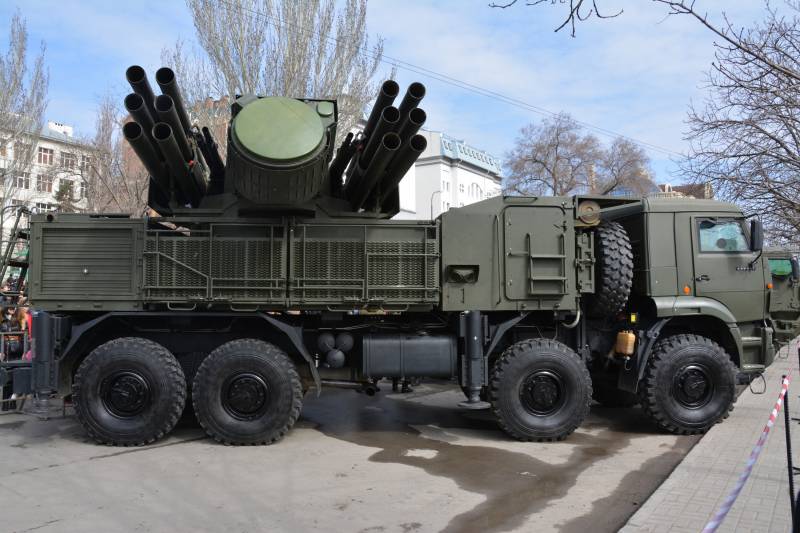
Information